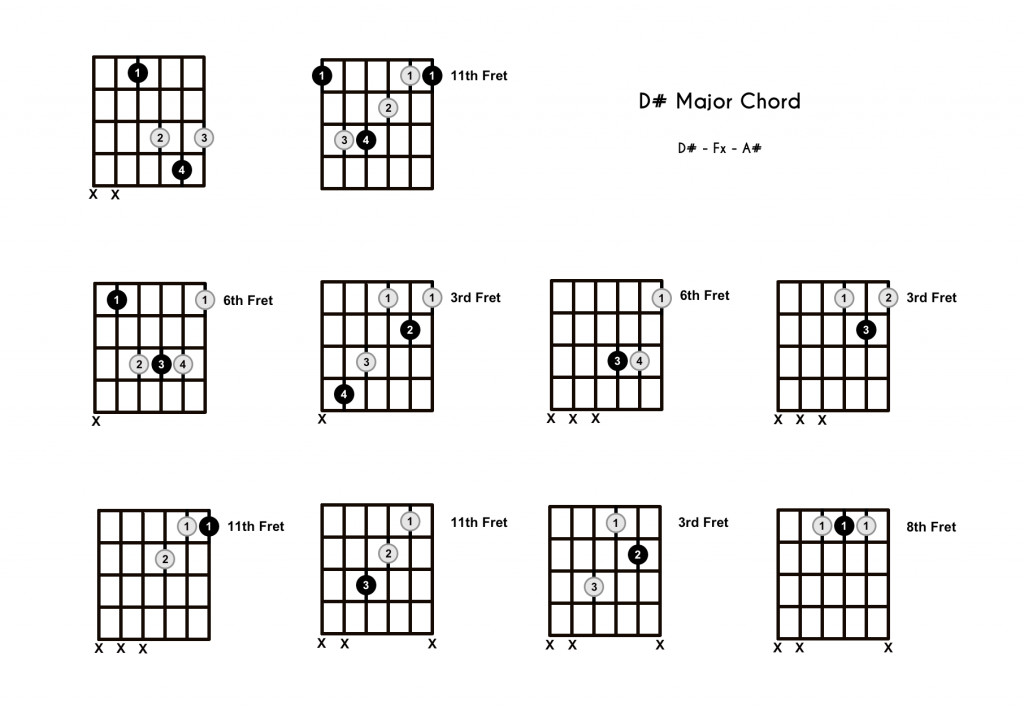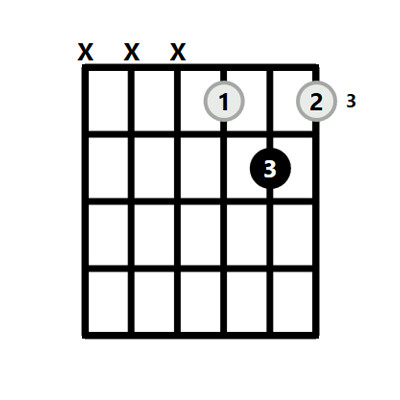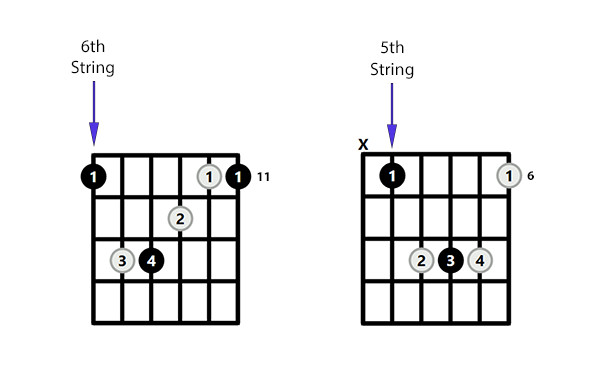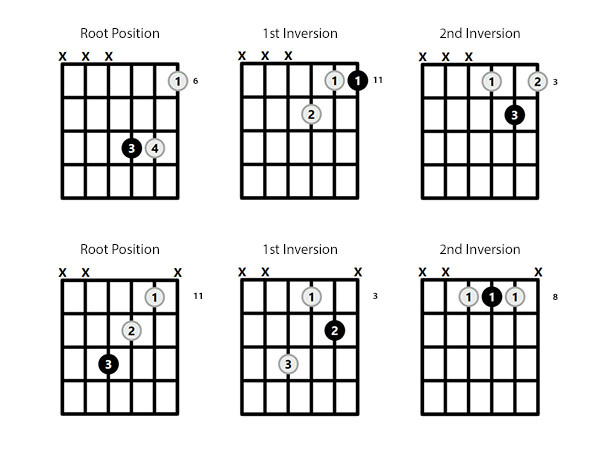The D# Guitar Chord, often considered the enigmatic twin of its more common counterpart, Eb, holds a unique place in the world of guitar music. While technically enharmonically equivalent to the Eb Major chord, understanding the D# chord in its own right unlocks a deeper comprehension of music theory and expands your fretboard fluency. This guide dives deep into the D# chord, exploring its theory, various shapes, and practical applications for guitarists of all levels.
Unpacking the D# Major Chord: Theory Essentials
To truly grasp the D# chord, let’s delve into its theoretical underpinnings. Like all major chords, the D# Major chord is built upon a triad – three notes that create its characteristic bright and uplifting sound. These notes are:
- D# (Root): The foundational note and namesake of the chord.
- Fx (Major Third): This might look unusual, but Fx (F double sharp) is the enharmonic equivalent of G. In the context of the D# Major scale, Fx is theoretically correct.
- A# (Perfect Fifth): The final note that completes the major triad.
These notes are derived from the D# Major scale, specifically the 1st, 3rd, and 5th degrees. The intervals within the D# Major chord, starting from the root (D#), are:
- Major Third: The interval between D# and Fx.
- Minor Third: The interval between Fx and A#.
- Perfect Fourth: The interval from A# back to the octave of D#.
Understanding these intervals is crucial for recognizing the D# chord’s construction and how it relates to other chords and scales. In the key of D# Major, the D# chord naturally takes the position of the I chord (tonic). The complete set of chords in the key of D# Major are:
- I: D# Major
- ii: E# minor
- iii: Fx minor
- IV: G# Major
- V: A# Major
- vi: B# minor
- vii°: Cx diminished
Exploring 10 Shapes for the D# Major Chord
Visualizing and playing different shapes of the D# chord across the fretboard is essential for versatility. Here are 10 distinct ways to play the D# Major chord, offering various voicings and positions:
 D# Major Chord – 10 Shapes
D# Major Chord – 10 Shapes
The Standard D# Chord Shape: Root 5 Barre Chord
The most commonly taught and played D# chord shape is a root 5 barre chord variation. This shape is based on the E Major barre chord shape but moved up the fretboard to position the root on D#. Typically, it starts on the 6th fret, with the root note (D#) located on the 6th string. Often, guitarists will barre across the strings with their index finger, though sometimes, as depicted below, the index finger only frets the root note on the 6th string.
 D Sharp Chord Guitar
D Sharp Chord Guitar
The “Easy” D# Chord Shape: Simplified Voicing
For beginners or situations where you need a quicker, less demanding D# chord, the “easy” D# shape is an excellent option. This simplified voicing utilizes only the top three strings and is directly related to the open D chord shape. Imagine the open D chord shape moved up one fret – that’s your easy D# chord. This shape is particularly useful in chord progressions where you transition quickly to or from other chords on the higher strings.
 Easy D Sharp Chord Guitar
Easy D Sharp Chord Guitar
Step-by-Step Guide to Playing the Standard D# Major Chord
If you’re new to the standard D# chord shape, following these step-by-step instructions can be incredibly helpful to ensure correct finger placement and sound:
- Index Finger: Place your index finger on the 6th fret of the 5th string. This is your root note, D#.
- Middle Finger: Place your middle finger on the 8th fret of the 4th string.
- Ring Finger: Place your ring finger on the 8th fret of the 3rd string.
- Pinky Finger: Place your pinky finger on the 8th fret of the 2nd string.
- Strumming: Avoid strumming the 6th string. Strum down from the 5th string to the 1st string.
By methodically following these steps, you can verify your finger positioning and confidently play the standard D# Major chord. This detailed approach is especially beneficial when you’re unsure if you are interpreting a chord diagram correctly.
Barre Chord Mastery: D# Chord Root 6 and Root 5 Shapes
As mentioned earlier, the D# chord is frequently played as a barre chord. Barre chords are movable shapes, making them incredibly valuable for playing chords all over the neck. You can play the D# chord using two primary barre chord shapes:
- Root 6 Barre Chord Shape: Based on the E Major shape, barre on the 11th fret to play D#.
- Root 5 Barre Chord Shape: Based on the A Major shape, barre on the 6th fret to play D#. (This is the “standard” shape discussed earlier).
 D Sharp Barre Chord Guitar
D Sharp Barre Chord Guitar
Mastering these barre chord shapes provides you with the ability to play the D# chord (and other major chords) in various positions along the guitar neck, enhancing your musical vocabulary and fretboard navigation skills.
D# Major Triads: Inversions and Voicings
Beyond full chord shapes, exploring triads – three-note chords – offers a deeper understanding of chord construction and provides alternative voicings. D# Major triads can be voiced in three inversions:
- Root Position: D#, Fx, A# (Root note is the lowest)
- 1st Inversion: Fx, A#, D# (Third of the chord is the lowest)
- 2nd Inversion: A#, D#, Fx (Fifth of the chord is the lowest)
Here are six different ways to play D# Major triads, incorporating these inversions, offering compact and melodically interesting chord voicings:
 D Sharp Major Triad Guitar
D Sharp Major Triad Guitar
Musical Context: Keys Featuring the D# Chord
Understanding where the D# chord fits within musical keys expands its practical application. The D# chord naturally appears in the following major keys:
- D# Major: As the tonic (I) chord. (D#, E#m, Fxm, G#, A#, B#m, Cxdim)
- A# Major: As the dominant (V) chord. (A#, B#m, Cxm, D#, E#, Fxm, Gxdim)
- G# Major: As the major IV chord. (G#, A#m, B#m, C#, D#, E#m, Fxdim)
Knowing these key relationships allows you to confidently incorporate the D# chord into chord progressions and songwriting within these keys.
Alternative and Useful D# Chord Shapes
Beyond the standard shapes, several alternative D# chord voicings exist, offering unique sonic textures and fingerings. While not as common as the root 5 barre chord, these shapes can add variety and interest to your playing. Experimenting with these alternative shapes can lead to discovering new musical ideas and expanding your chord vocabulary.
D# Chord Substitutions: Expanding Harmonic Possibilities
The D# Major chord can often be substituted with related chords to create harmonic variations and nuances. Effective substitutions include:
- D# sus4 chord: Adds a suspended, unresolved quality.
- D# sus2 chord: Creates a brighter, more open sound.
- D# add9 chord: Introduces a jazzy, extended harmony.
Conversely, the D# Major chord itself can serve as a simpler substitute for more complex chords that share D# as the root, such as the D# Major 7 chord or D#7 chord. However, it’s important to note that D# Major cannot substitute for minor chords.
Scales for Soloing and Improvisation Over the D# Chord
To effectively solo or improvise over a D# Major chord, or to craft melodies in your songwriting, certain scales are particularly well-suited. The most common and effective scales for the D# Major chord include:
- D# Major Scale: The most fundamental choice, naturally outlining the chord tones.
- D# Major Pentatonic Scale: A simplified major scale, excellent for melodic phrasing.
- D# Lydian Mode: Adds a raised 4th (G natural) for a brighter, more ethereal sound.
Experimenting with these scales will unlock melodic possibilities and allow you to create compelling solos and improvisations over the D# Major chord.
Further Exploration
 Get Guitar Chords Galore eBook
Get Guitar Chords Galore eBook
A promotional banner for a guitar chords eBook, offering further learning resources for guitarists interested in expanding their chord knowledge and repertoire.
By mastering the D
